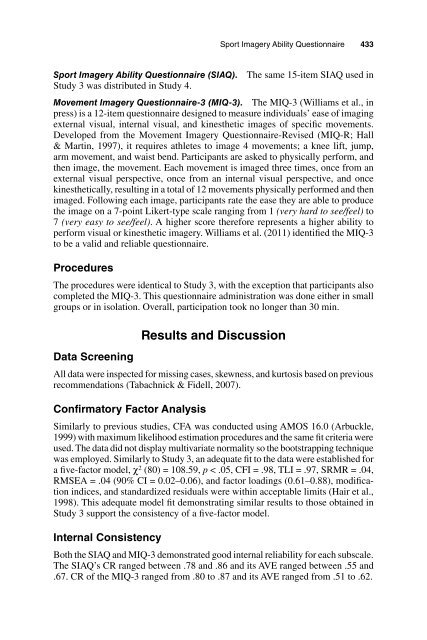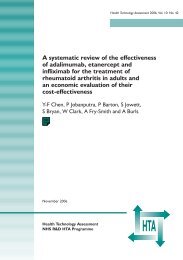Measuring Athlete Imagery Ability: The Sport ... - ResearchGate
Measuring Athlete Imagery Ability: The Sport ... - ResearchGate
Measuring Athlete Imagery Ability: The Sport ... - ResearchGate
Create successful ePaper yourself
Turn your PDF publications into a flip-book with our unique Google optimized e-Paper software.
<strong>Sport</strong> <strong>Imagery</strong> <strong>Ability</strong> Questionnaire 433<br />
<strong>Sport</strong> <strong>Imagery</strong> <strong>Ability</strong> Questionnaire (SIAQ). <strong>The</strong> same 15-item SIAQ used in<br />
Study 3 was distributed in Study 4.<br />
Movement <strong>Imagery</strong> Questionnaire-3 (MIQ-3). <strong>The</strong> MIQ-3 (Williams et al., in<br />
press) is a 12-item questionnaire designed to measure individuals’ ease of imaging<br />
external visual, internal visual, and kinesthetic images of specific movements.<br />
Developed from the Movement <strong>Imagery</strong> Questionnaire-Revised (MIQ-R; Hall<br />
& Martin, 1997), it requires athletes to image 4 movements; a knee lift, jump,<br />
arm movement, and waist bend. Participants are asked to physically perform, and<br />
then image, the movement. Each movement is imaged three times, once from an<br />
external visual perspective, once from an internal visual perspective, and once<br />
kinesthetically, resulting in a total of 12 movements physically performed and then<br />
imaged. Following each image, participants rate the ease they are able to produce<br />
the image on a 7-point Likert-type scale ranging from 1 (very hard to see/feel) to<br />
7 (very easy to see/feel). A higher score therefore represents a higher ability to<br />
perform visual or kinesthetic imagery. Williams et al. (2011) identified the MIQ-3<br />
to be a valid and reliable questionnaire.<br />
Procedures<br />
<strong>The</strong> procedures were identical to Study 3, with the exception that participants also<br />
completed the MIQ-3. This questionnaire administration was done either in small<br />
groups or in isolation. Overall, participation took no longer than 30 min.<br />
Data Screening<br />
Results and Discussion<br />
All data were inspected for missing cases, skewness, and kurtosis based on previous<br />
recommendations (Tabachnick & Fidell, 2007).<br />
Confirmatory Factor Analysis<br />
Similarly to previous studies, CFA was conducted using AMOS 16.0 (Arbuckle,<br />
1999) with maximum likelihood estimation procedures and the same fit criteria were<br />
used. <strong>The</strong> data did not display multivariate normality so the bootstrapping technique<br />
was employed. Similarly to Study 3, an adequate fit to the data were established for<br />
a five-factor model, χ 2 (80) = 108.59, p < .05, CFI = .98, TLI = .97, SRMR = .04,<br />
RMSEA = .04 (90% CI = 0.02–0.06), and factor loadings (0.61–0.88), modification<br />
indices, and standardized residuals were within acceptable limits (Hair et al.,<br />
1998). This adequate model fit demonstrating similar results to those obtained in<br />
Study 3 support the consistency of a five-factor model.<br />
Internal Consistency<br />
Both the SIAQ and MIQ-3 demonstrated good internal reliability for each subscale.<br />
<strong>The</strong> SIAQ’s CR ranged between .78 and .86 and its AVE ranged between .55 and<br />
.67. CR of the MIQ-3 ranged from .80 to .87 and its AVE ranged from .51 to .62.
















